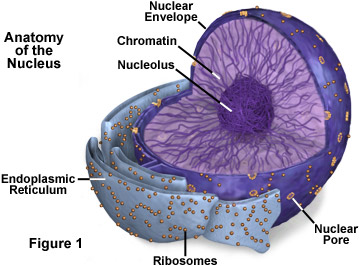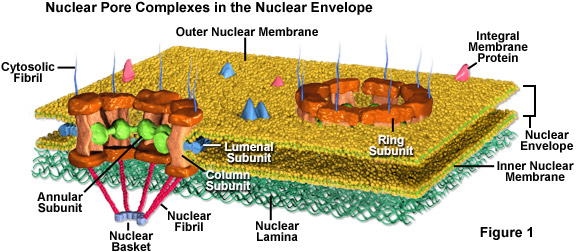Daily Challenge
September 11, 2012 - The Nucleus
Admistrative: Milestone Paper
Your first Milestone Paper is due to be loaded next week. Remember that you can use any information written in your daily challenge to help build this paper.The nucleus defines the eukaryotic cell. Why would we say that? Remember yesterdays discussion about prokaryotes and eukaryotes? The principle differences is the presence or absence of a nucleus. Eukaryotes have a nucleus, while the prokarotes don't. Presence of a nucleus also implies the ability to create internal membranes.
The nucleus is a central structure present in eukaryotic cells, and is the site where we find the cell's DNA. It is a highly regulated structure, and one function is to ensure the protection and stability of the cell's genetic information. We also consider the nucleus an organelle.
 The nucleus is a double membrane bound structure, which means that there are two lipid bilayers that make up the nuclear envelope.The outer layer of the nuclear envelope gives rise to the endomembranous system, which includes the Endoplasmic Reticulum and the Golgi Apparatus.
The nucleus is a double membrane bound structure, which means that there are two lipid bilayers that make up the nuclear envelope.The outer layer of the nuclear envelope gives rise to the endomembranous system, which includes the Endoplasmic Reticulum and the Golgi Apparatus. To gain access to the inside of the nucleus, you must first move through nuclear pores. Remember that phospholipid bilayers are selectively permeable. The nuclear pores are large. The purpose here is not to control ion movment, but macromolecule movement. For example, messager RNA (mRNA) will need to leave the nucleus so that proteins can be made in the cytoplasm. mRNA is a large linear macromolecule, so to move it from the nuclear compartment to the cytoplasm, you have to pass the mRNA through nuclear pores. These pores are regulated so that only specifically tagged
 macromolecules can move though. So the goal is not to protect the DNA from small molecules, but provide protection from macromolecules. Click on the link for more information on the nuclear pore complex.
macromolecules can move though. So the goal is not to protect the DNA from small molecules, but provide protection from macromolecules. Click on the link for more information on the nuclear pore complex.Inside of the nucleus, you will find a region known as the nucleolus. In micrographs (pictures generated from microscopes), you will see the nucleolus staining differently than the rest of the nucleus. It appears denser. This is a region of active transcription (making RNA). Ribosomal RNA, Transfer RNA, and Small Nuclear RNA is continually being transcribed (synthesized) in this area, hence the reason for the difference in appearance.
The job of the nucleus is to protect the cells DNA. We will discuss DNA in more detail later, but for now know that it holds the code (in the form of nucleotides) for how to create the different forms of RNA, and thus how to create proteins. Changes in DNA will change the resulting protein's primary structure (sequence of amino acids). As we learned earlier, changes to the primary structure will affect the secondary and tertiary structures, and thus, the function of the protein. DNA needs to be protected from oxidizing agents, digestive agents, and any other harmful macromolecule.
NOTE: prokaryotes do not have a nucleus! The DNA of a prokaryote is found in the cytoplasm of the cell. As DNA has a tendency to stain differently than the rest of the cytoplasm, we can generally visualize the region of the cell where the DNA is found. In prokaryotes, this region is referred to as a nucleoid.

Daily Challenge
In your own words, describe the structure and function of the nucleus, including the action of the nuclear pores.Link to Formum
No comments:
Post a Comment